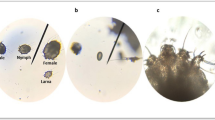Abstract
Sporothrix schenckii is the etiologic agent of sporotrichosis, a mycosis of world-wide distribution more commonly occurring in tropical regions. The immunological mechanisms involved in the prevention and control of sporotrichosis are not fully understood but apparently include both the humoral and cellular responses. In the present investigation, cellular immunity was evaluated by in vivo and in vitro tests in mice infected with yeast-like forms of S. schenckii. The disease developed systemically and cellular immunity was evaluated for a period of 10 weeks. The soluble antigen utilized in the tests was prepared from yeast form of the fungus through the sonication (20 min: 10 sonications at 50 W at 2-min intervals). Delayed hypersensitivity and lymphocyte transformation tests showed that the cellular immune response was depressed between the 4th and 6th week of infection when the animals were challenged with the soluble fungal antigen. This depression frequently indicates worsening of the disease, with greater involvement of the host. This is a promising field of research for a better understanding of the pathogeny of this mycosis.
Similar content being viewed by others
References
Calich VLG, Fazioli RA, Teixeira HC, Russo M, Singer-Vermes LM, Burger E, Vaz CAC. Mechanisms of host-resistance to Paracoccidioides braziliensis. In: Congress of the International Society for Human and Animal Mycology-Isham, Barcelona: JR Prous Science, 1988: 154–59.
Hanifin JM, Ray LF, Lobitz Jr WC. Immunological reactivity in dermatophytosis. Br J Dermatol 1974; 90: 1–8.
Meneghini CL, Angelini G, Boifazi E, Lospalluti M. Clinical and immunological aspects of sporotrichosis cuta nea. Contact Dermatitis 1978; 4: 33–40.
Shimonaka H, Noguchi T, Kawai K, Hasegawa I, Nasawa I, Ito Y. Immunochemical studies on the human pathogen Sporothrix schenckii: effects of chemical and enzymatic modification of the antigenic compounds upon immediate and delayed reactions. Infect Immun 1975; 11: 1187–94.
Roberts GD, Larsh HW. The serologic diagnosis of extracutaneous sporotrichosis. AJCP 1971; 56: 597–600.
Kaplan E, Ivens MS. Fluorescent antibody staining of Sporotrichum schenckii in cultures and clinical materials. J Invest Dermatol 1960; 35: 151–59.
Plouffe JF, Silva J, Fekety R, Reinhalter E, Browne R. Cell-mediated immune responses in sporotrichosis. J Infect Dis 1979; 139(2): 152–57.
Carlos IZ. Contribuicão ao estudo da infeccão sistêmica pelo fungo Sporothrix schenckii em camundongos. Avaliacão do processo inflamatório e seu inter-relacionamento com a resposta imune celular. Ribeirão Preto, School of Medicine of Ribeirão Preto — USP (Thesis — Doctor). 1989: 104pp.
Karlin JV, Nielsen HS. Serologic aspects of sporotrichosis J Infect Dis 1970; 121(3): 316–27.
Albornoz MB, Villa Nueva E, Torres ED. Application of immunoprecipitation techiniques to the diagnosis of cutaneous and extracutaneous forms of sporotrichosis. Mycopathologia 1984; 85: 177–83.
Matter SE, Bailey DM, Sexton DJ. Immune deficiency presenting as disseminated sporotrichosis. J Okla State Med Assoc 1984; 77(4): 114–17.
Bravo TC, Andrade A. Estudio de las cutirreacciones a la histoplasmina, coccidioidina, esporotricinas y lepromina. Salud Publica Mex 1968; 10(2): 173–94.
Cox RA. Immunologic studies of patients with histoplasmosis. Am Rev Respir Dis 1979; 120: 143–49.
Mota NGS, Rezkallah-Iwasso MT, Peracoli MTS, Audi RC, Mendes RP, Marcondes J, Marques SA, Dillon NL, Franco MF. Correlation between cell-mediated immunity and clinical forms of paracoccidiodomycosis. Trans Royal Soc Trop Med Hyg 1985; 79: 765–72.
Murphy JW. Cellular responses against Cryptococcus neoformans antigens. In: Congress of the International Society for Human and Animal Mycology-Isham, Barcelona. JR Prous Science 1988: 36–40.
Lipstein-Fresch E, Isenberg HD, Singer C, Cooke O, Grenwlad RA. Disseminated Sporothrix schenckii infection with arthritis in a patient with acquired immunodificiency syndrome. J Rheumat 1985; 12(4): 805–08.
Dominguez-Soto L, Hojyo-Tomoka MT. The intradermal sporotrichin test and the diagnosis of sporotrichosis. Inter. J Dermatol 1983; 22(9): 520.
Rowley DA, Fitch FW, Stuart EP, Kohler H, Consenze H. Specific supression of imune responses. Science 1973; 181: 1133–41.
Lowry OH, Rosenbrough NJ, Farr AL, Randall RJ. Protein measurement with Folin phenol reagent. J Biol Chem 1951; 193: 265–75.
Author information
Authors and Affiliations
Rights and permissions
About this article
Cite this article
Carlos, I.Z., da Graca Sgarbi, D.B., Angluster, J. et al. Detection of cellular immunity with the soluble antigen of the fungus Sporothrix schenckii in the systemic form of the disease. Mycopathologia 117, 139–144 (1992). https://doi.org/10.1007/BF00442774
Received:
Accepted:
Issue Date:
DOI: https://doi.org/10.1007/BF00442774




